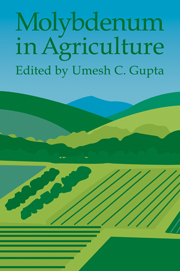Book contents
- Frontmatter
- Contents
- List of contributors
- Preface
- 1 Introduction
- 2 Chemistry and Mineralogy of Molybdenum in Soils
- 3 Distribution and Mobility of Molybdenum in the Terrestrial Environment
- 4 Biochemical Significance of Molybdenum in Crop Plants
- 5 Soil and Plant Factors Affecting Molybdenum Uptake by Plants
- 6 Analytical Techniques for Molybdenum Determination in Plants and Soils
- 7 Testing for Molybdenum Availability in Soils
- 8 Molybdenum Availability in Alkaline Soils
- 9 Deficient, Sufficient, and Toxic Concentrations of Molybdenum in Crops
- 10 Symptoms of Molybdenum Deficiency and Toxicity in Crops
- 11 Sources and Methods for Molybdenum Fertilization of Crops
- 12 Yield Responses to Molybdenum by Field and Horticultural Crops
- 13 Responses of Forage Legumes and Grasses to Molybdenum
- 14 Molybdenum and Sulfur Relationships in Plants
- 15 Molybdenum in the Tropics
- Index
2 - Chemistry and Mineralogy of Molybdenum in Soils
Published online by Cambridge University Press: 10 December 2009
- Frontmatter
- Contents
- List of contributors
- Preface
- 1 Introduction
- 2 Chemistry and Mineralogy of Molybdenum in Soils
- 3 Distribution and Mobility of Molybdenum in the Terrestrial Environment
- 4 Biochemical Significance of Molybdenum in Crop Plants
- 5 Soil and Plant Factors Affecting Molybdenum Uptake by Plants
- 6 Analytical Techniques for Molybdenum Determination in Plants and Soils
- 7 Testing for Molybdenum Availability in Soils
- 8 Molybdenum Availability in Alkaline Soils
- 9 Deficient, Sufficient, and Toxic Concentrations of Molybdenum in Crops
- 10 Symptoms of Molybdenum Deficiency and Toxicity in Crops
- 11 Sources and Methods for Molybdenum Fertilization of Crops
- 12 Yield Responses to Molybdenum by Field and Horticultural Crops
- 13 Responses of Forage Legumes and Grasses to Molybdenum
- 14 Molybdenum and Sulfur Relationships in Plants
- 15 Molybdenum in the Tropics
- Index
Summary
Introduction
Molybdenum (Mo) is important in ecosystems as a micronutrient for both plants and animals. It can also accumulate in the environment in toxic concentrations. Molybdenum is used widely in industrial societies and is an important fertilizer element in some agricultural systems. Soil Mo averages approximately 1.0–2.3 mg kg–1 as a crustal constituent, making it 53rd in abundance (Krauskopf, 1979), but it can accumulate as a result of biogeochemical cycling to 300mgkg–1 or more in shales rich in organic matter. However, the common range of Mo concentrations in U.S. soils is 0.8–3.3 mg kg–1 (dry weight) (Kubota, 1977). In soils, Mo can be found in four major fractions: (1) dissolved Mo in soil solution (watersoluble), (2) Mo occluded with oxides (e.g., Al, Fe, and Mn oxides), (3) Mo solid phases [e.g., molybdenite (MoS2), powellite (CaMoO4), ferrimolybdite (Fe2(MoO4)3), wulfenite (PbMoO4)], and (4) Mo associated with organic compounds.
Numerous processes take place in soil solution, including plant uptake, ion complexation, adsorption and desorption, and precipitation and dissolution (Figure 2.1). As shown in Figure 2.1, Mo solid phases dissolve upon contact with water and provide dissolved Mo in soil solution. The free molybdate ion reacts with metals to form complexes and ion pairs in soil solution. Plants absorb dissolved Mo, mainly as, from soil solution. Removal of by plants disrupts the electroneutrality of a soil solution.
- Type
- Chapter
- Information
- Molybdenum in Agriculture , pp. 4 - 22Publisher: Cambridge University PressPrint publication year: 1997
- 24
- Cited by



